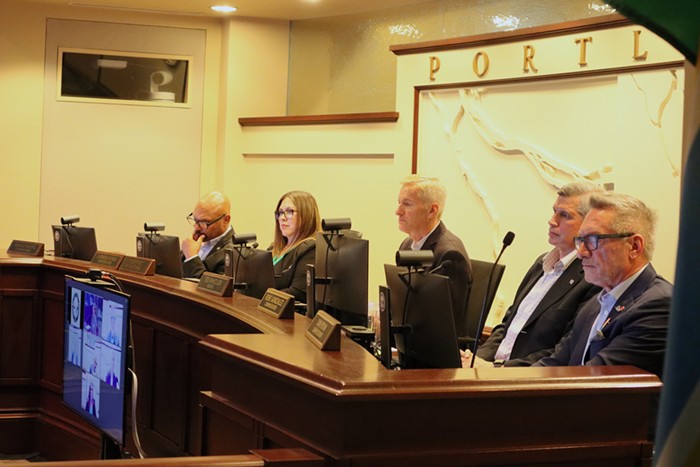Robert Yoder Froelick Adelhart
Through Sept 30
Robert Yoder doesn't simply peruse the aisles of an art supply store for materials. No--the Seattle artist goes shopping along the roadside, searching for discarded road signs. Yoder then fragments these gems into rectangle and square puzzle pieces, tiling them onto a plywood surfaces. In an immediate sense, the results are simply cool: The graphic brand of cool fit for the living room walls of an affluent hipster or the kind of cool that could provide a backdrop for a parade of edgy, urban fashion.
However, Yoder's work quickly transcends this superficial description to encompass more intricate issues; solid backgrounds, primarily in a bright orange, set up a vivid contrast for black fragments--fragments recognizable as former letters, numbers, and traffic symbols. Signs that used to direct drivers to proceed at 55 mph, watch for pedestrians, or pay attention to upcoming curves have been dissected, becoming part of Yoder's unique, visual language.
Sets of lines feed into abstract compositions reminiscent of the Russian artists El Lissitzky and Kazimir Malevich. Like the two historical fellows, Yoder is conscious of the power of geometric shapes, informal composition and the weight of bold color. Two panels titled "Crown" and "Maple" form a diptych composed from "safety" yellow and glossy black.
The lines formed from graffiti tags and the retired symbols create a dynamic flow of shapes between the two panels. Foremost they are urban relics: honoring the ever-present, dueling states of construction and deconstruction. The materials come from an act of deconstruction, but the overall art work mimics an architectural drawing, thus becoming part of Yoder's Plans for a Beautiful City.
"Perry Hall" is a larger work, constructed from signs in shades of pearled whites with symbols shaped from black and silver paint. The composition of Yoder's new "codes" looks like technical information, the silvery surface part of an enlarged silicon chip. The most significant element of the piece is the textural quality achieved by the aged signs: scratches, dents, and discoloration all combine to create an abstract description of urban renewal. Yoder seems to illustrate that the pace of change has quickly set in, leaving only unfamiliar fragments behind.
The surface is also marred by bullet-sized holes. With this element, Yoder offers another tidbit of tension. It brings to mind, "Where did these signs come from, which neighborhood, and who lived there?" In Plans for a Beautiful City, Yoder has created a document of a generic sense of place.
In this way, much like Marie Sester's multimedia work in Fictional Cities at PICA a few months ago, Yoder addresses a universal view of place, and offers the viewer the window seat, as the plane passes over the grids below.












